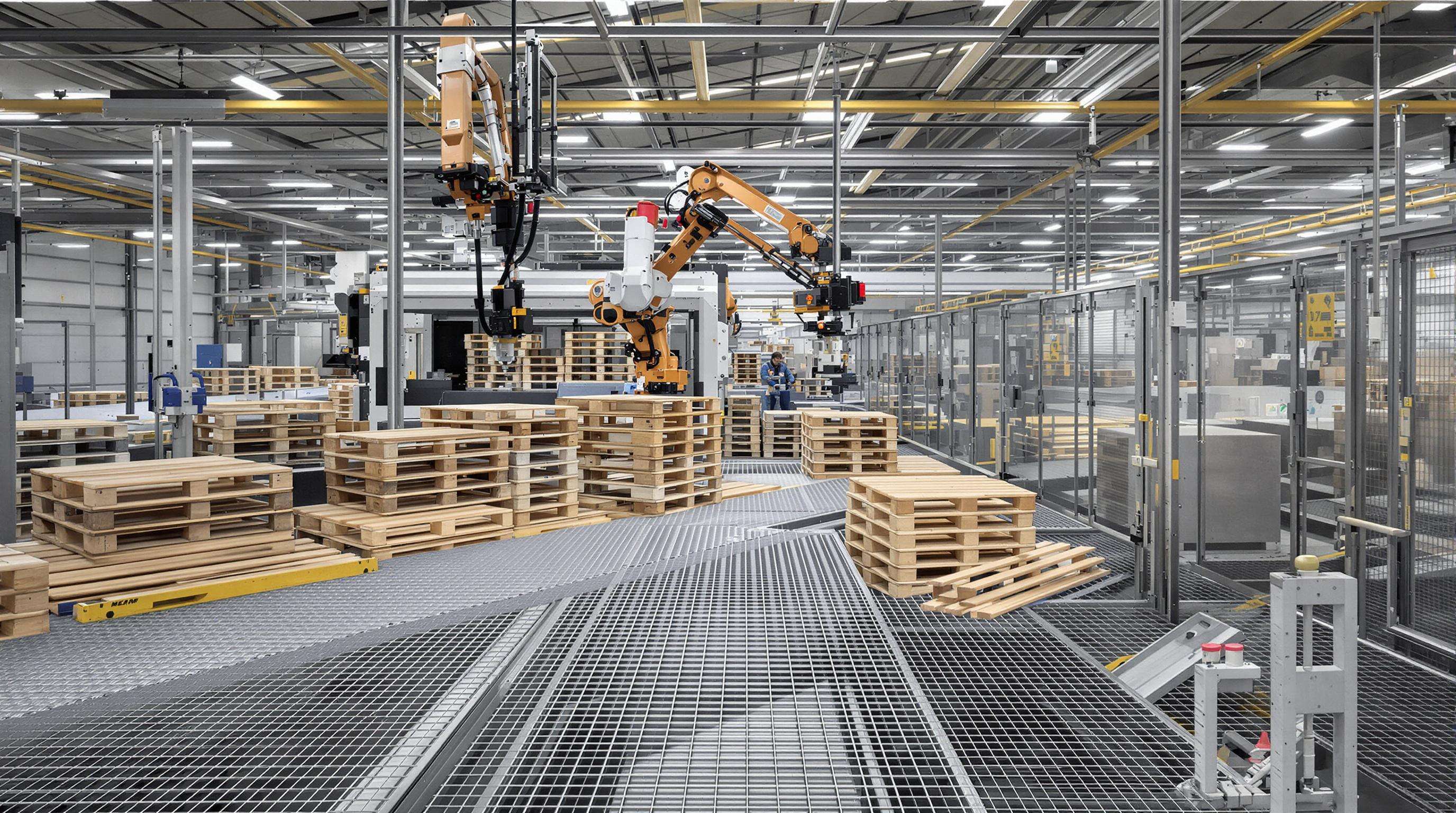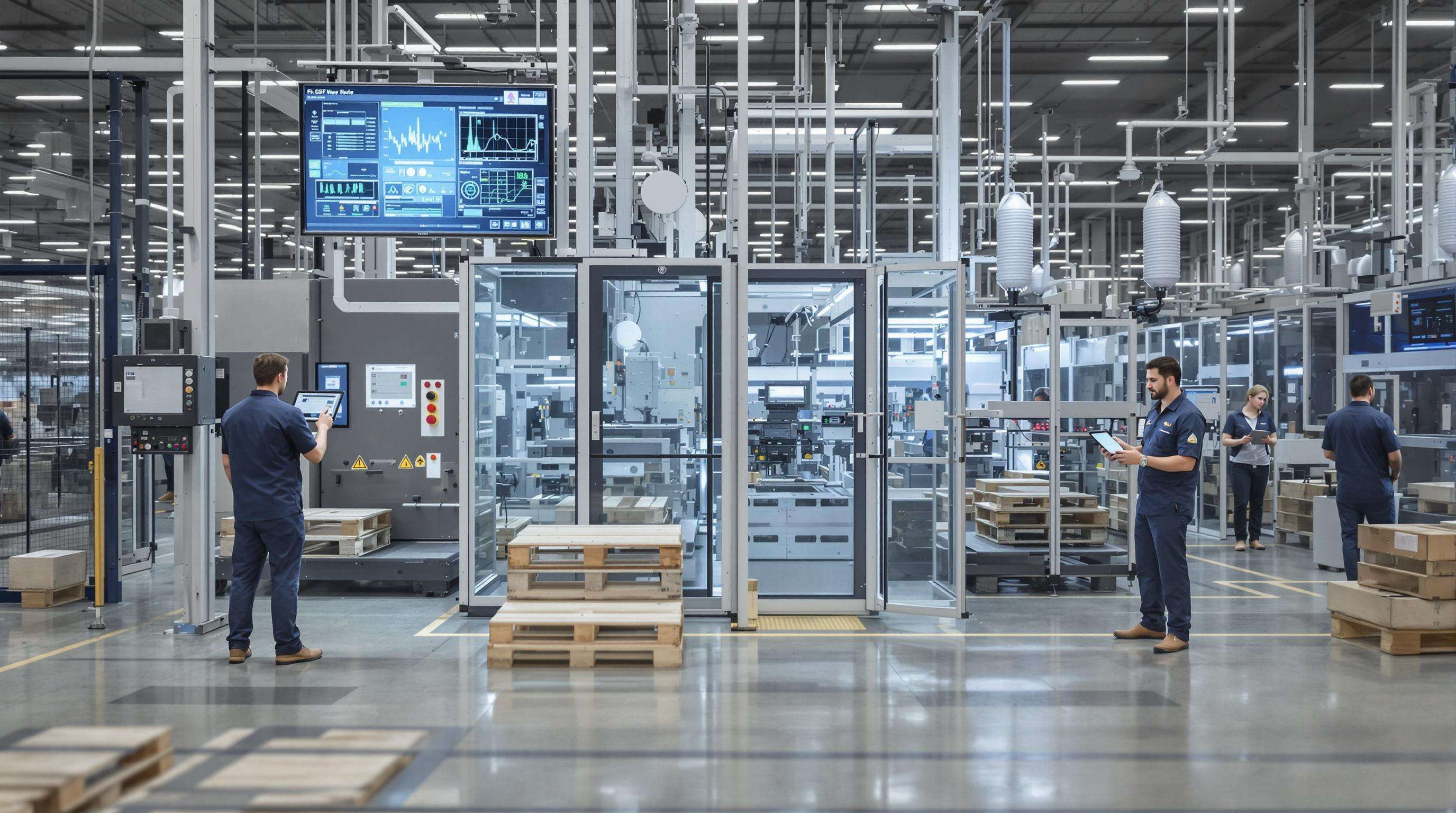From Manual to Smart: The Evolution of Pallet Manufacturing Equipment
Pallet manufacturing equipment has transformed dramatically since its manual origins in the early 20th century, driven by industrial demands for efficiency and precision. This evolution reflects broader manufacturing trends, where automation and robotics have become essential for meeting global supply chain needs.
Historical Development of Pallet Manufacturing Equipment
Back in the day, making pallets was all about hand tools and basic jigs. Workers would cut wood by hand and hammer in those nails, which led to all sorts of inconsistencies and plenty of safety issues on the job site. Things started changing big time during the 1980s when factories began using semi-automated nailing machines along with some early programmable systems. The introduction of CNC tech really changed everything for operators who could now tweak settings based on different pallet dimensions. According to the Manufacturing Automation Report from 2023, this improvement actually boosted standardization across outputs by around 40 percent while cutting down on wasted materials too. What we see today are these modular design innovations that can handle well over 200 different pallet setups right off the same production line.
Impact of Industrial Automation on Pallet Production Efficiency
Pallet manufacturing has undergone a major transformation thanks to automation, which dramatically cuts down on the need for human workers while getting things made faster. When companies switch to fully automated systems, they typically see around a two-thirds reduction in manual labor needs and production speeds jump nearly half compared to what was possible with semi-automated approaches. Quality control has gotten much better too. Vision inspection tech now keeps defect rates incredibly low, bringing them down from about 8% all the way to just 0.5% at large scale operations. And there's more good news for plant managers worried about equipment breakdowns. By adding those smart IoT sensors throughout the facility, maintenance teams can predict problems before they happen, resulting in roughly a third less downtime across most automated manufacturing sites.
Key Milestones in Automation and Robotics in Pallet Manufacturing
- 1990s: Programmable logic controllers (PLCs) enabled synchronized workflows across nailing, trimming, and stacking stations.
- 2010s: Collaborative robots (cobots) began handling repetitive tasks like board placement, working alongside human operators.
- 2020s: AI-driven predictive analytics emerged, allowing real-time adjustments to material feeds and energy use.
By 2023, 82% of large-scale pallet manufacturers had adopted at least one smart manufacturing technology, illustrating the sector’s rapid transition toward data-driven production models.
Core Components and Technologies in Modern Pallet Manufacturing Equipment

Modern pallet manufacturing equipment integrates three critical subsystems to optimize production: frame assembly systems, automated fastening technologies, and quality control automation. Frame assembly systems utilize servo-controlled material feed mechanisms that position boards with ±0.5 mm precision, reducing material waste by 12–18% compared to manual systems (Industrial Packaging Report 2023).
Automated nailers now achieve 3.2 nails/second through dual-head configurations, enabling production rates exceeding 1,200 pallets per 8-hour shift in high-volume facilities. These systems combine pneumatic actuators with RFID-tagged tooling that automatically adjusts nail patterns for 37+ pallet configurations.
Machine vision systems are solving a real problem many industries face right now. Studies show around 14 percent of all manual pallet inspections end up missing important flaws. Newer systems come equipped with these fancy hyperspectral cameras that check each pallet at 23 different points for structural issues. Field tests have shown these setups catch defects with nearly 99.97% accuracy, which is pretty impressive when we think about it. Beyond just finding problems, this kind of automated quality check makes sure everything meets those strict ISO 445:2024 requirements. And let's not forget how much time it saves too. No more waiting for someone to manually go through each pallet at the end of production lines. The whole process moves along so much smoother now.
Automation in Pallet Production: Boosting Speed, Precision, and Throughput
Advances in automated pallet manufacturing equipment with real-time monitoring
Modern pallet manufacturing has started incorporating real time sensors along with internet connected devices that keep track of important numbers such as how tight those fasteners are and whether the wood is properly aligned during production. The constant monitoring helps cut down on wasted materials and stops unexpected shutdowns by catching problems long before they actually cause issues on the factory floor. Factory supervisors can boost their output rates thanks to these dashboard displays showing live data. Smart software running behind the scenes analyzes things like machine vibrations and heat signatures throughout the day, adjusting settings automatically when needed. What we see here isn't just better equipment performance but also safer working conditions for everyone involved in making these wooden pallets.
Role of programmable logic controllers (PLCs) in production process automation
Programmable Logic Controllers form the core of how synchronized pallet production actually works in modern facilities. These specialized industrial computers handle all sorts of step-by-step operations, including getting those boards positioned just right before moving onto automated nailing processes that need to happen within fractions of a second. When compared to old fashioned methods involving manual valve tweaking or relying on mechanical timers, PLC systems create much more consistent pallet sizes. Plus they make it possible to tweak designs quickly simply by changing software settings instead of going through expensive retooling procedures. According to industry data from IMA in 2023, these control systems cut down on human mistakes by around 85%, which means products coming off the line look pretty much identical batch after batch despite whatever variations might occur during manufacturing.
Case study: 40% throughput increase using automation in pallet operations
When a large pallet manufacturing company installed automated systems throughout their production line, they saw real improvements in how things ran without needing to hire more people. The upgrades basically fixed those annoying slowdowns that used to happen when moving materials around, and now the robotic nail guns work smoothly with parts coming down the conveyor belts. Looking at the data from the machines themselves shows something pretty impressive: they're making about 40% more pallets each hour compared to before, and fewer defective ones too—around 19% less waste after just half a year. What's interesting is what happened to the workers. Instead of doing all the same old repetitive jobs day after day, many operators started spending time checking product quality instead. This shift makes sense because automation does two important things at once—it gets more done while also keeping workers safer from those dangerous manual tasks.
Comparative analysis of semi-automated vs fully automated pallet manufacturing systems
| Criteria | Semi-Automated Systems | Fully Automated Systems |
|---|---|---|
| Initial investment | Lower ($150k–$350k) | Higher ($500k–$900k) |
| Output capacity | 50–120 pallets/hour | 200–400 pallets/hour |
| Labor dependency | 3–5 operators per shift | 1–2 monitoring technicians |
| Flexibility | Rapid design adjustments | Limited by predefined programs |
Fully automated configurations excel in high-volume scenarios where production consistency outweighs upfront costs, while semi-automated alternatives suit manufacturers prioritizing smaller batches and flexible workflows. Though ROI timelines extend 12–16 months for full automation, the labor savings and throughput gains typically compensate beyond 18-month horizons.
Palletizers and Automated Handling Systems in Industrial Material Flow
Types of Robotic and Gantry Palletizers in Material Handling Automation
Today's pallet production shops typically depend on two main automated options: those fancy robotic arm palletizers and the big gantry systems. The robotic ones have these six-axis arms that can do around 1,500 stacking cycles every hour. Pretty impressive when dealing with all sorts of oddly shaped products, which makes them great for facilities handling mixed loads. Then there are the gantry systems that really shine at fast, repetitive jobs. They can move payloads weighing up to 2 tons within their 10 meter working area. A recent report from Material Handling Automation (probably from 2024) found that nearly 8 out of 10 manufacturers are actually mixing both types together these days. Makes sense really, since combining them saves valuable factory floor space while keeping things moving efficiently through the facility.
Synchronization of Palletizers and Automated Pallet Handling Systems with Production Lines
Advanced PLC networks enable real-time coordination between palletizers and upstream/downstream equipment. Vision-guided systems automatically adjust stacking patterns when sensors detect production line speed variations of ±15%. This synchronization reduces buffer inventory by 40% compared to manual systems while maintaining <0.5% error rates in load stabilization.
Data: 30–50% Reduction in Labor Costs with Automated Pallet Operations
Automation in pallet manufacturing creates significant OPEX savings:
| Metric | Manual System | Automated System |
|---|---|---|
| Labor hours per 1k pallets | 18.7 | 6.2 (-66%) |
| Pallet damage rate | 3.8% | 0.9% (-76%) |
| Energy consumption | 41 kWh | 28 kWh (-32%) |
These efficiencies explain why 63% of logistics operators now mandate automated pallet handling in RFPs—a 22-point increase since 2020 (Material Handling Institute, 2023).
Smart Manufacturing and IoT Integration in Pallet Manufacturing Equipment

IoT-enabled sensors for predictive maintenance in pallet manufacturing equipment
Built-in IoT sensors continuously monitor vibration patterns and thermal signatures across critical machinery components. These diagnostics detect anomalous readings signaling potential wear, enabling maintenance before failures occur and reducing unplanned interruptions.
Cloud-based monitoring platforms for smart manufacturing and IoT integration
Centralized cloud platforms aggregate operational data from production equipment, providing plant managers remote visibility into line performance via unified dashboards. Automated alerts notify personnel about efficiency bottlenecks requiring intervention.
Real-time data analytics for optimizing automation in pallet production
Edge computing processors analyze throughput metrics as pallets move through assembly stages, identifying optimization opportunities like cutter speed adjustments. Algorithm-driven refinements sustain peak output while minimizing material waste.
Industry paradox: High upfront cost vs long-term ROI in smart pallet systems
While IoT-enabled pallet systems demand significant initial investment ($200k–$500k per line), they typically deliver 30–40% operational cost savings within 3 years by slashing maintenance expenses and unplanned downtime. The ROI calculation becomes favorable when considering lifecycle efficiency gains versus manual alternatives.
FAQ
What are the key benefits of automation in pallet manufacturing?
Automation in pallet manufacturing offers various advantages, including reduced manual labor requirements, faster production speeds, improved quality control, and minimized downtime through predictive maintenance.
How has CNC technology changed pallet manufacturing?
CNC technology allows operators to adjust settings for different pallet dimensions, improving standardization and reducing material waste by enabling more precise cuts.
What is the role of IoT in managing equipment maintenance?
IoT sensors monitor machinery for potential wear and defects, allowing for predictive maintenance before failures occur, which helps reduce unplanned interruptions on the production line.
How does automation affect labor costs in pallet manufacturing?
With automation, labor hours required per thousand pallets significantly decrease while maintaining product quality and efficiency, resulting in considerable operational cost savings.
What are the initial investment costs for automated systems in pallet production?
Initial costs for fully automated systems are higher, ranging from $500,000 to $900,000, while semi-automated systems range from $150,000 to $350,000. However, the long-term savings and increased production efficiency often offset these initial expenses.
Table of Contents
- From Manual to Smart: The Evolution of Pallet Manufacturing Equipment
- Core Components and Technologies in Modern Pallet Manufacturing Equipment
-
Automation in Pallet Production: Boosting Speed, Precision, and Throughput
- Advances in automated pallet manufacturing equipment with real-time monitoring
- Role of programmable logic controllers (PLCs) in production process automation
- Case study: 40% throughput increase using automation in pallet operations
- Comparative analysis of semi-automated vs fully automated pallet manufacturing systems
- Palletizers and Automated Handling Systems in Industrial Material Flow
-
Smart Manufacturing and IoT Integration in Pallet Manufacturing Equipment
- IoT-enabled sensors for predictive maintenance in pallet manufacturing equipment
- Cloud-based monitoring platforms for smart manufacturing and IoT integration
- Real-time data analytics for optimizing automation in pallet production
- Industry paradox: High upfront cost vs long-term ROI in smart pallet systems
-
FAQ
- What are the key benefits of automation in pallet manufacturing?
- How has CNC technology changed pallet manufacturing?
- What is the role of IoT in managing equipment maintenance?
- How does automation affect labor costs in pallet manufacturing?
- What are the initial investment costs for automated systems in pallet production?


